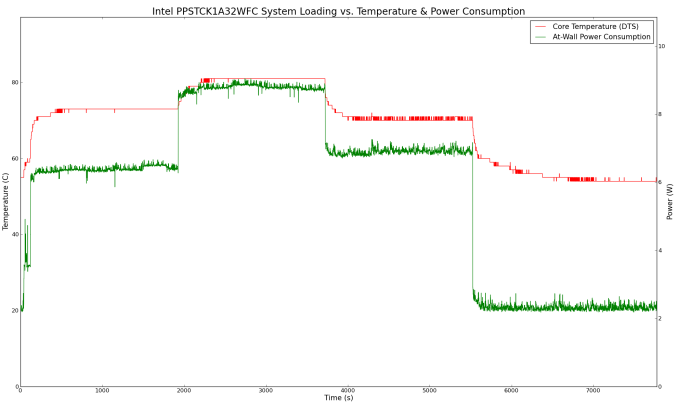Intel PPSTCK1A32WFC Bay Trail-T Compute Stick Review
by Ganesh T S on April 22, 2015 11:00 AM EST- Posted in
- Systems
- Intel
- Bay Trail
- HDMI Stick
Power Consumption and Thermal Performance
The power consumption at the wall was measured with a 1080p display being driven through the HDMI port. In the graphs below, we compare the idle and load power of the Intel PPSTCK1A32WFC with other low power PCs evaluated before. For load power consumption, we ran Furmark 1.12.0 and Prime95 v27.9 together. The numbers track what one might expect from the combination of hardware components in the machine.


It is not a surprise (given the tablet platform that is inside the Compute Stick) that the unit proves to be the least power-hungry of the lot.
Our thermal stress routine starts with the system at idle, followed by 30 minutes of pure CPU loading. This is followed by another 30 minutes of both CPU and GPU being loaded simultaneously. After this, the CPU load gets removed, allowing the GPU to be loaded alone for another 30 minutes. The various clocks in the system throughout this routine are presented in the graph below.
The cores burst up to 1.83 GHz for a few seconds, before settling down to 1.58 GHz during the pure CPU loading process. The core temperature plateaus around 76 C, while power consumption at the wall is slightly more than 6 W. With thee GPU also loaded, the temperature reaches 80 and the power consumption is closer to 9 W. However, the CPU and GPU frequencies adjust themselves to be within the power budget. The cores run at 1.3 GHz while the GPU is clocked at slightly more than 300 MHz. Removing the CPU load brings temperatures back to 75 C and power consumption to less than 7 W. The CPU cores idle at 500 MHz, while the GPU clocks in around 440 MHz.
It is a very effective thermal solution and the temperatures do not raise any alarm. The presence of active cooling definitely helps in this situation.












103 Comments
View All Comments
ToTTenTranz - Wednesday, April 22, 2015 - link
IMO, lack of Ethernet and terrible WiFi performance kills the product from the start.This is obviously intended to turn a TV into a media host device with the added functionality of running Windows, but if a very slow WiFi connection is the only way to get connected, then the product is rather useless.
With a decent WiFi AC receiver, this would be the ideal Steam Home Streaming client.
Krysto - Wednesday, April 22, 2015 - link
Slow and expensive for what it offers - I'd say that defines Intel pretty well these days.Krysto - Wednesday, April 22, 2015 - link
Oh and don't forget this is the kind of "Celerons" and "Pentiums" we're going to see from now on - for $100-$160 a chip.Drumsticks - Wednesday, April 22, 2015 - link
Not really sure why you're ignoring the $50 Celeron G1820 which is a 2.7Ghz Haswell chip, but hell if it makes you feel better go ahead.Drumsticks - Wednesday, April 22, 2015 - link
Edit: And if you're referring to mobile bay/cherry trail parts, it's not like consumers can personally buy those anyways.Refuge - Wednesday, April 22, 2015 - link
Thats right, because Microsoft lets Intel use Windows for FREE.Forgot that deal.
v1001 - Wednesday, April 22, 2015 - link
Wait a minute so every single one of these is going to crap out when people go to add the windows updates?? How is that acceptable? They can't seriously expect everyone who buys this to find a work around do they? Is Windows 10 smaller? Any luck there with upgrading to that in July? I want to buy a few of these for some TV's. But I'm not going to cut it that close on the updates, I mean what happens on the next windows update and that's it, you went over and can't do a single thing after that...Marc GP - Wednesday, April 22, 2015 - link
Looks like you'd be much better served with something like the HP Stream Mini.Uplink10 - Thursday, April 23, 2015 - link
Stop advertising HP Stream Mini, Zotac miniPC or Gygabite BRIX barebones are better and you can even put in youtr desired HDD and RAM and they only cost around 120$. See my post above.dtgoodwin - Wednesday, April 22, 2015 - link
I'm surprised that they had issues with updates. I'm running a Winbook 7" with only 1GB of ram and 16 GB on board storage. I've added a microSD 64-gig card, but windows updates will only stage/install on the c: partition. I've got less than 1 GB free, but all the updates have applied - I just got this two weeks ago, so I'd consider it a fairly comparable situation. I did run disk cleanup including system updates, but I never ran into an error. It is too bad that there's no way to extend the drive space of c: using a microSD, or to have Windows seamlessly use it for temp files, or be able to move other files to it. It would also greatly help if they allowed you to move the "recovery" partition to a USB stick and be able to recover by placing that back in the device. Recovering 5 GB of space would be really helpful. Of course, my tablet only cost $40.00. It also plays NetFlix and Youtube output to HDMI acceptably, and even my medium bitrate Blu-Ray rips.